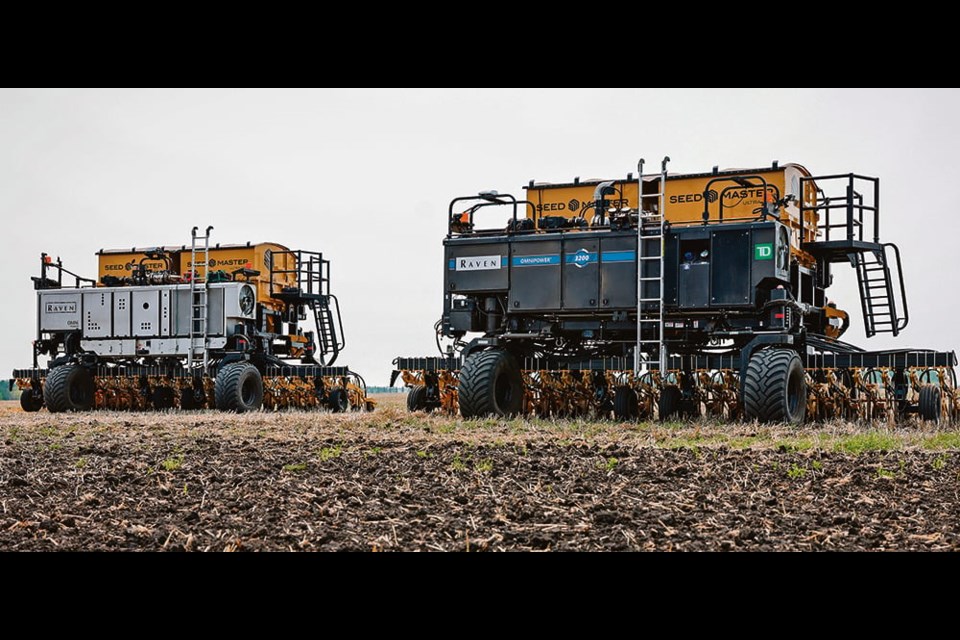WESTERN PRODUCER — Raven had 13 Omnipower units working in full-scale fields and gathering data since 2020. One of the most informative trials was conducted by Olds College, in Olds, Alta., which logged more than 10,000 acres.
Omnipower is Raven’s autonomous implement that serves as self-driven seeder, sprayer and fertilizer applicator. It takes about an hour to switch between working tools
The 1,200-gallon liquid tank is the same as a Patriot and it uses Hawkeye pulse width modulation.
Remove the Omnipower liquid tank, and the eight-ton granular box can be installed in the opening. Basically, Omnipower uses the same dual liquid/granular product system Case IH has employed for years.
Raven sales manager Ben Voss said the dozen prototype units tested on farms the past three growing seasons have been returned to Raven and will likely be upgraded to the new 3200 specifications, and then put out in the field to test again.
The exception is the unit bought outright by Olds College in 2020. Olds wanted to continue their autonomous research, so this winter they traded their three-year-old model for a new 3200 unit.
“They got a deal most farmers would envy. They traded in a three-year-old machine, then we gave them a new 2023 model 3200 for free. Next, we updated their trade-in and gave it back to them, also for free. There’s a reason for all this. We gained a lot of good data from those three years Olds had the unit. They provided more documentation than we got from farmers who had machines,” said Voss, adding that Olds will now be able to run the two machines side-by-side and next to conventional equipment to collect a lot more comparative data in 2023.
“Ultimately, the guidance, steering and knowledge of safety we gain from Omnipower will transfer directly into our tractor platforms.”
Augmenta will be available for future Omnipower units. Voss said this on-the-go variable-rate system is compatible with Raven controllers. Just introduced to Canada this spring, Augmenta regulates rates of fertilizer, plant growth regulators, fungicides, herbicides, defoliators and desiccants based on information from five sensors aimed 18 metres in front of the applicator.
He said upgrades of the used machines to the 3200 criteria include more power and refinements to electrical, hydraulic and mechanical systems. With these upgrades, the three-year-old units have the same things that are now standard on the new 3200.
“All Raven systems on the Omnipower are the same as on farmer-available, over-the-counter systems. Afterall, that’s the business Raven is in. There was no need to change the systems when we installed them on the autonomous machines. It still functions with the same kind of prescription map.”
Voss said Raven is in no rush to mass produce the Omnipower. Units farmers are using this spring are leased or rented, plus there are a few outright purchases. But they all go back to Raven in Regina or South Dakota at the end of each growing season. He said the company is still in developmental stages.
The results of the Olds 2022 comparison are presented in a table that compares conventional and Omnipower systems in seeding, spraying and spreading.
Roy Maki is the Smart Farm research manager at Olds and is leading the autonomous agriculture equipment research. He said the autonomous system does not appear to be competitive with conventional systems in terms of work rate measured in hectares per hour.
“Conventional sprayers and spreaders run at 20 miles per hour or faster. The Omnipower is limited to about 12 miles per hour because of limited horsepower. If you look at the chart, you see the Omnipower is down on power. There’s a direct correlation between horsepower and field capacity,” Maki said, adding that the new 3200 has 25 hp more than the original models.
When asked about possible financial benefits to the farmer, Maki said that autonomy will be driven primarily by a shortage of capable farm labour. Farmers will be forced to use autonomous equipment. The first obvious benefit is lower labour costs.
“Right now we have supervised autonomy, meaning the machines need to be monitored and supervised in the line of sight. While that machine is running on its own out in the field, you can now sit in your truck and fully concentrate on your farm management tasks. Instead of phoning your suppliers at nine at night for deliveries the next morning, now you can make those arrangements mid-afternoon. Your truck becomes your mobile farm office.
The Olds project was headed by Joy Agnew, associate vice-president of applied research. “One of the really cool elements is we’re operating the autonomous technology side-by-side with conventional equipment to compare the two approaches.”
She said side-by-side method generated valuable information field, fuel and labour efficiency.
The research team is also working with Raven engineers on evaluating and improving the Omnipower perception system, which allows the implement to recognize and avoid obstacles.
Agnew said another benefit is the hands-on learning. Every year, one or two students are offered an on-site work placement focused on using Raven equipment. As a result, they become experts with the technology. Plus, the school’s agriculture and agronomy students are exposed to activities that build their understanding of the latest technology.
Maki’s research team has maintained a close partnership with Raven since purchasing the original Omnipower in 2020.
“As we gather more data, we gain more insights into the performance of autonomous equipment.”
“Raven sees the value of the research we’re doing, and how we use Omnipower to perform significant seeding, spraying and spreading. We’re able to run the equipment more efficiently, get more acreage coverage and improve field efficiencies with uninterrupted hands-off operation. Autonomous technology is available and mature enough for broad acre farming.”
Total project budget was $3.94 million. The Canadian Agri-Food Automation and Intelligence Network contributed $1.104 million.

